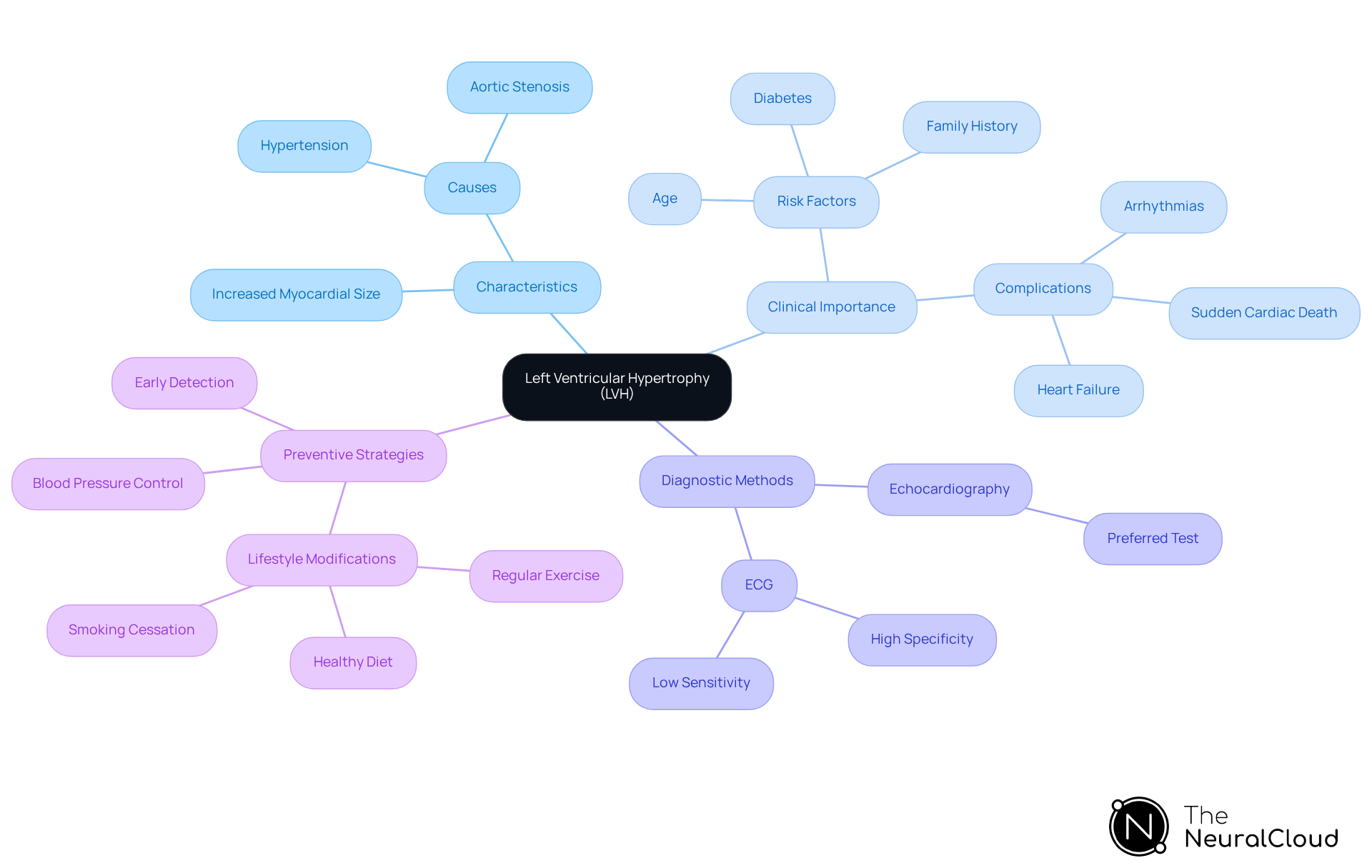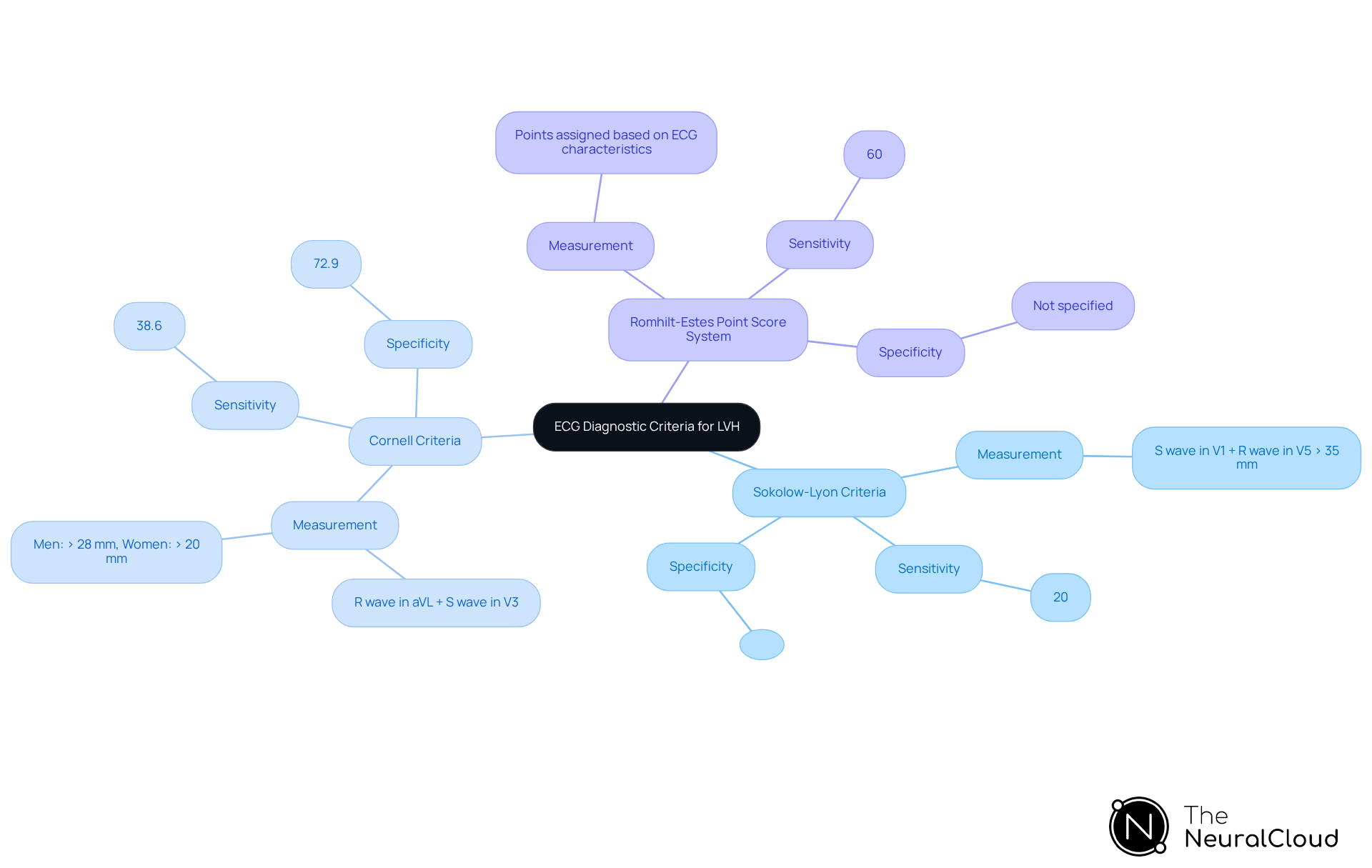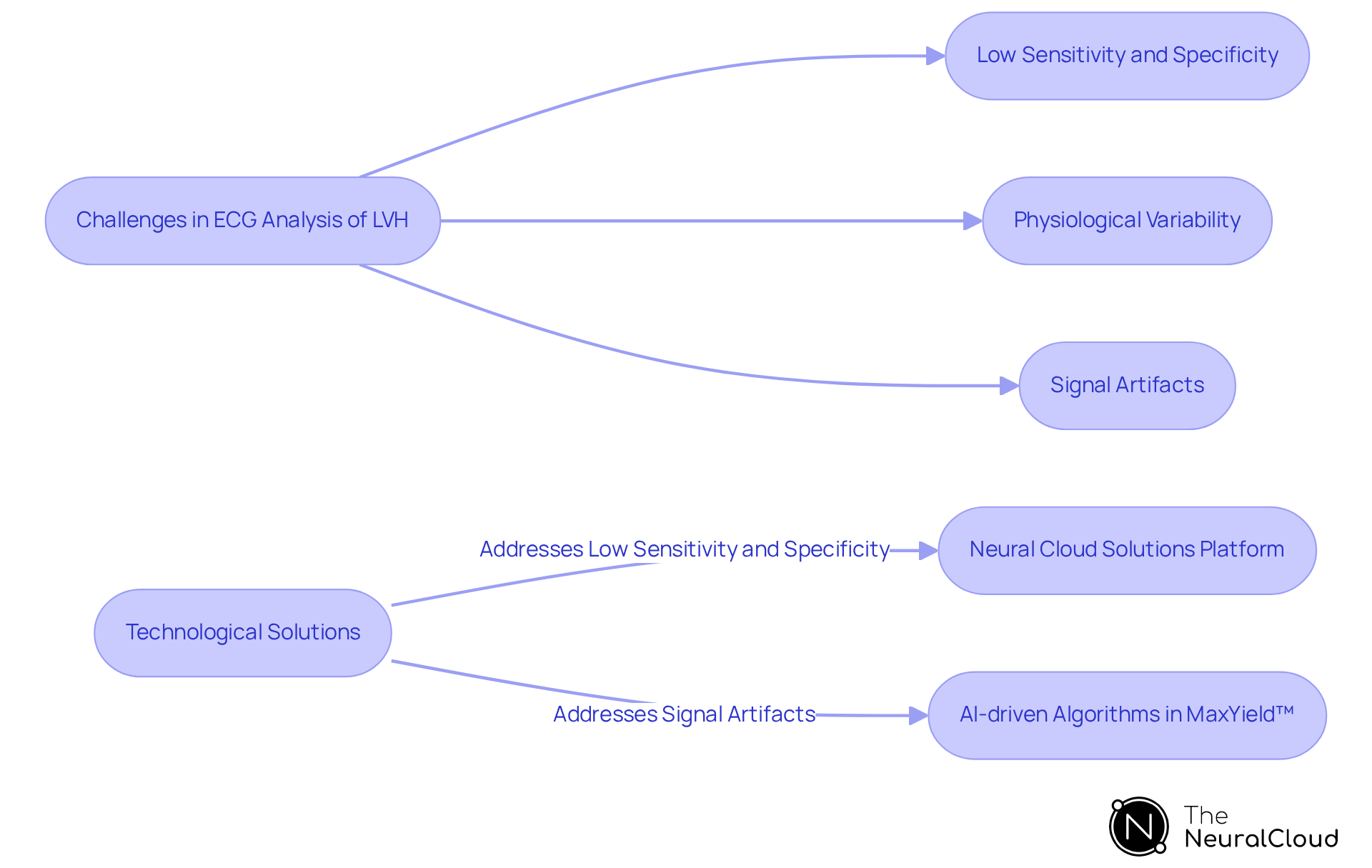Overview
The article emphasizes the mastery of ECG analysis techniques for diagnosing Left Ventricular Hypertrophy (LVH), underlining its clinical significance and the challenges posed by traditional ECG methods.
It begins by outlining the difficulties in ECG analysis, such as:
- Low sensitivity
- Noise interference
These factors can hinder accurate diagnoses.
Advancements in technology, particularly through Neural Cloud Solutions' platform, are highlighted as a means to enhance diagnostic accuracy. This platform addresses these issues effectively, ultimately facilitating improved patient management and outcomes.
Introduction
Left Ventricular Hypertrophy (LVH) presents a significant challenge in cardiovascular health, frequently remaining undetected until it results in serious complications. This article explores essential techniques for analyzing LVH through ECG, emphasizing the critical nature of early detection and its potential benefits for patient outcomes.
Traditional ECG methods, however, encounter limitations in sensitivity and specificity. This raises an important question: how can technological advancements enhance the accuracy of LVH diagnoses and ultimately improve patient care?
Define Left Ventricular Hypertrophy and Its Clinical Importance
Left Ventricular Hypertrophy (LVH) is characterized by an increase in the size of the left ventricle's myocardial fibers, often resulting from conditions such as hypertension or aortic stenosis. Clinically, LVH is significant as it serves as an independent risk factor for cardiovascular morbidity and mortality, including heart failure, arrhythmias, and sudden cardiac death. Understanding LVH is essential for clinicians, as can lead to timely interventions that may prevent adverse outcomes. The condition can be identified through various diagnostic methods, including echocardiography and the left ventricular hypertrophy ECG, with ECG being a widely accessible tool in clinical settings. However, while ECG is cost-effective, its high specificity but low sensitivity limits its clinical utility for left ventricular hypertrophy ECG diagnosis.
This is where Neural Cloud Solutions' platform comes into play. MaxYield™ utilizes advanced noise filtering and distinct wave recognition to enhance the efficiency of ECG analysis. The platform allows for the rapid isolation of ECG waves even in recordings affected by baseline wander, movement, and muscle artifacts. This capability addresses the challenges of physiological variability and signal artifacts, ultimately improving the overall diagnostic yield.
Furthermore, blood pressure control is crucial for preventing complications in two-thirds of LVH patients who are hypertensive. The asymptomatic nature of LVH may lead to delayed treatment, emphasizing the need for early detection. Case studies illustrate the importance of early detection; for instance, patients diagnosed with LVH through routine screenings often experience better management of their condition, reducing the risk of severe complications.
Cardiologists emphasize that recognizing the signs of LVH early can facilitate proactive treatment strategies, ultimately improving cardiovascular health. As one expert noted, 'The presence of LVH plays a crucial role in hypertension management,' highlighting the need for a collaborative approach among healthcare professionals to ensure comprehensive care for patients at risk.

Explore ECG Diagnostic Criteria for Left Ventricular Hypertrophy
The identification of left ventricular hypertrophy ECG primarily relies on voltage standards that evaluate the amplitude of the QRS complex in specific leads. The most commonly utilized criteria include:
- Sokolow-Lyon Criteria: This method sums the depth of the S wave in lead V1 and the height of the R wave in lead V5. A total exceeding 35 mm indicates LVH. Despite its widespread application, the Sokolow-Lyon guidelines exhibit a sensitivity of only 20% and a specificity over 85%, highlighting its limitations in certain populations.
- Cornell Criteria: This standard assesses the R wave in lead aVL alongside the S wave in lead V3. For men, a sum greater than 28 mm, and for women, greater than 20 mm, suggests LVH. The Cornell voltage standards demonstrate a sensitivity of 38.6% and a specificity of 72.9%, making it a more reliable option in hypertensive populations.
- Romhilt-Estes Point Score System: This scoring system assigns points based on various ECG characteristics, with a score of 4 or more indicating probable LVH and 5 or more suggesting it is very likely. The Romhilt-Este's index has a reported sensitivity of 60%, serving as a valuable tool for clinicians in diagnosing LVH based on specific ECG changes.
Understanding these standards is crucial for the and treatment of individuals with suspected left ventricular hypertrophy ECG. Recent studies stress the importance of integrating voltage criteria with non-voltage criteria to improve diagnostic accuracy, particularly in instances where traditional methods may produce false negatives. As the field progresses, ongoing research continues to refine these diagnostic tools, ensuring that healthcare professionals can effectively identify and manage LVH.
The 'Neural Cloud Solutions' platform transforms this process by utilizing [advanced AI-driven signal mapping](https://theneuralcloud.com/post/10-innovations-in-ai-ecg-interpretation-for-enhanced-cardiac-care) through its patent-pending X-Factor algorithm. This technology automates the labeling of ECG signals, accurately mapping the PQRST waveforms and providing essential wave durations and intervals. By effectively managing physiological variability and noise, the system enhances the clarity of ECG readings, enabling healthcare professionals to identify actionable insights more efficiently. The integration of advanced technology with established diagnostic standards for left ventricular hypertrophy ECG ensures that healthcare professionals can leverage innovative tools to enhance diagnostic output and streamline processes.

Address Challenges in ECG Analysis of LVH and Technological Solutions
Diagnosing Left Ventricular Hypertrophy (LVH) through ECG analysis presents several significant challenges:
- Low Sensitivity and Specificity: Traditional ECG criteria often exhibit low sensitivity, particularly in patients with left bundle branch block (LBBB), leading to missed diagnoses. Studies show that patients with left ventricular hypertrophy ECG have lower rates of in-hospital revascularization (45% vs. 69%) when presenting with Non-ST-Elevation Myocardial Infarction (NSTEMI), highlighting the urgent need for accurate detection.
Physiological variability, such as body habitus, electrode placement, and patient demographics, can significantly influence left ventricular hypertrophy ECG readings, complicating result interpretation. For example, the presence of conduction abnormalities alongside left ventricular hypertrophy ECG can further obscure diagnostic clarity, necessitating careful consideration of baseline abnormalities.
- Signal Artifacts: Noise and artifacts can obscure true ECG signals, making it difficult to accurately identify left ventricular hypertrophy ECG. Although the reliance on computerized ECG interpretations has increased, these systems often show significant inaccuracies, particularly in identifying left ventricular hypertrophy ECG, with a 6.6% lower accuracy compared to cardiologists.
To address these challenges, like Neural Cloud Solutions' platform are being integrated into ECG analysis. The system features advanced noise filtering and distinct wave recognition to isolate critical data, even in recordings with high levels of noise and artifact. This capability enhances the diagnostic yield by salvaging previously obscured sections of lengthy Holter, 1-Lead, and patch monitor recordings. By automating the analysis process and providing a clear, 'neuralized' signal, this system allows healthcare professionals to concentrate on clinical decision-making rather than manual interpretation, ultimately leading to improved patient outcomes. The evolution of AI-driven algorithms in MaxYield™ marks a pivotal advancement in overcoming the limitations of traditional ECG criteria, especially in diagnosing left ventricular hypertrophy ECG, as they can generate diagnoses that align with expert cardiologist evaluations.

Conclusion
Left Ventricular Hypertrophy (LVH) is a critical condition that poses significant risks to cardiovascular health. Understanding its implications and mastering the techniques for ECG analysis are essential for healthcare professionals. Timely and accurate detection of LVH through advanced diagnostic methods can lead to better patient outcomes, emphasizing the importance of integrating technology into traditional analysis.
The article highlights key diagnostic criteria for LVH, including the Sokolow-Lyon, Cornell, and Romhilt-Estes systems, each with its strengths and limitations. It also addresses the challenges faced in ECG analysis, such as low sensitivity and the impact of physiological variability and signal artifacts. The introduction of innovative solutions like Neural Cloud Solutions' MaxYield™ platform demonstrates how technology can enhance the diagnostic process, making it more efficient and reliable.
MaxYield™ offers several features that significantly improve ECG analysis. It utilizes advanced algorithms to enhance signal clarity, effectively reducing noise and artifacts. This leads to more accurate readings, which is crucial for timely diagnosis. Furthermore, the platform's user-friendly interface allows healthcare professionals to interpret results with ease, facilitating quicker decision-making in patient care.
Ultimately, the significance of mastering LVH ECG analysis cannot be overstated. As advancements continue to shape the future of cardiovascular diagnostics, healthcare professionals are encouraged to embrace these technologies and collaborate on early detection strategies. This proactive approach will not only improve individual patient care but also contribute to better management of cardiovascular diseases on a broader scale.
Frequently Asked Questions
What is Left Ventricular Hypertrophy (LVH)?
Left Ventricular Hypertrophy (LVH) is characterized by an increase in the size of the left ventricle's myocardial fibers, often caused by conditions such as hypertension or aortic stenosis.
Why is LVH clinically important?
LVH is clinically significant because it is an independent risk factor for cardiovascular morbidity and mortality, including heart failure, arrhythmias, and sudden cardiac death. Early detection can lead to timely interventions that may prevent adverse outcomes.
How can LVH be diagnosed?
LVH can be identified through various diagnostic methods, including echocardiography and the left ventricular hypertrophy ECG. While ECG is widely accessible and cost-effective, it has high specificity but low sensitivity, which limits its clinical utility for diagnosing LVH.
What advancements does Neural Cloud Solutions' platform offer for ECG analysis?
Neural Cloud Solutions' platform, MaxYield™, utilizes advanced noise filtering and distinct wave recognition to enhance the efficiency of ECG analysis, allowing for the rapid isolation of ECG waves even in recordings affected by baseline wander, movement, and muscle artifacts.
Why is blood pressure control important for LVH patients?
Blood pressure control is crucial for preventing complications in two-thirds of LVH patients who are hypertensive. Effective management of blood pressure can significantly reduce the risk of severe complications.
What is the significance of early detection of LVH?
Early detection of LVH is important as it can lead to better management of the condition and reduce the risk of severe complications. Case studies show that patients diagnosed with LVH through routine screenings often experience improved outcomes.
How can healthcare professionals improve care for patients with LVH?
Cardiologists emphasize the importance of recognizing the signs of LVH early to facilitate proactive treatment strategies. A collaborative approach among healthcare professionals is essential to ensure comprehensive care for patients at risk.






